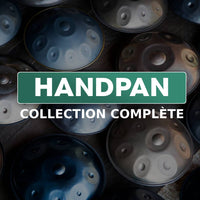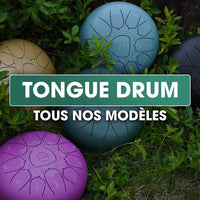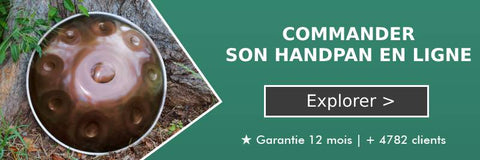The handpan , a fascinating musical instrument , captivates a global audience with its rich sound, combining melodies, harmonies , and rhythms. This percussion instrument , despite its recent introduction, offers unmatched versatility. For musicians of all levels, mastering the handpan requires refined technique.

This article reveals methods to perfect your playing, from holding the instrument correctly to performing sophisticated scales . Explore advanced strategies to enrich your musicality and tips to evolve your practice. Prepare yourself to excel in the art of hang drumming .
Also read: How to choose your first Handpan?
1. What is a handpan and how does it work?
The handpan is a hollow-bellied percussion instrument that can be mistaken, and rightly so, for a flying saucer. It is made up of two half-shells made of steel or other metal that have been hammered and shaped by hand to create a series of notes.
The handpan can be played standing or sitting, by placing it on the floor, on one's own legs or on a suitable support. To produce sounds with a hang , the player must strike the notes with the fingers, palms or by using playing sticks.
There are different striking and pressing techniques . The handpan is capable of producing a range of melodic and harmonic notes, making it a versatile instrument that can be used to play music from different genres.
Go meet your handpan by exploring our collection here .
2. Why is playing technique important for handpan?
Playing technique is important because it allows you to take full advantage of all the possibilities offered by this instrument . By mastering the different striking techniques, you will be able to produce a wide range of sounds and notes , which will give you the opportunity to play many styles of music and create original compositions.
Here is a video of a perfect example of a playing technique for beginners proposed by Thierry Bleton.
In addition, good playing technique will allow you to play smoothly and musically, which is crucial for achieving good results when playing solo or in a group. It will also help you produce quality sounds and avoid mistakes and technical problems that can ruin your performance.
Finally, playing technique is important for the handpan because it allows you to develop your creativity and musical expression. By mastering the different playing techniques, you will be able to play more freely and explore new musical ideas. This will help you progress as a musician and find your own way in the world of handpan.
3. The basics of handpan playing technique
has. How to hold the instrument?
How you hold your handpan is important to playing comfortably and effectively. There are several ways to hold the instrument, but here are some general tips:
- Sit comfortably and place the handpan in front of you. You can place it on your thighs, on a stand or on a flat surface. If you place it on your knees, make sure that the instrument does not touch other parts of your body, as this could absorb the vibrations and reduce the intensity of the notes played.
- Make sure your hands are a comfortable distance apart and that you can easily reach all the notes on the instrument. The notes should all be easily accessible so that you can play without limiting the instrument's potential.
- It is important to note that every player has their own way of holding the instrument and what suits one player will not necessarily suit another. The best way to find the playing position that suits you best is to practice and find what works best for you.
b. How to strike notes and produce sounds?

To produce sounds with your handpan, you can use your fingers, palms, or drumsticks. The technique you use will depend on the sound you want to produce. For example, you can strike a note with the tips of your fingers to produce a clear, crisp sound, or with the flat of your hand to produce a duller, lower-pitched sound.
Here are some additional tips to help you produce sounds with your handpan:
- Experiment with the different notes on the instrument to find the ones that work best for you and produce the sounds you want to play. Each hang is unique and has its own range of notes and sounds, so take the time to discover everything your instrument has to offer.
- Don't give up! Practice regularly to improve your playing technique. The more you practice, the more skilled you will become with your instrument. We are convinced that after a few hours of practice, the difference will be easily observable. Your playing will become more and more fluid and more pleasant to the ear.
- Listen to other handpan players and try to copy their playing techniques. This will help you discover new ways of producing sounds and playing the instrument. You can also watch videos online to learn different playing techniques and get inspired by how other musicians play the handpan.
c. How to play harmonics and scales?
Harmonics and scales are essential elements of handpan playing technique. They allow you to develop your musical ear and agility, and to become familiar with the different notes of the instrument.
Here are some tips for playing scales and ranges on your handpan:
- Start by learning the scale of your instrument (D minor for most handpan models). This will help you become familiar with the notes and develop your musical ear.
- Pay attention to the accuracy of the notes you play. Make sure you hit each note accurately to achieve a sound that is in tune and pleasing to the ear.
- Use a metronome if necessary to maintain a steady beat and work on your rhythmic precision.

In addition to working on your scales and ranges, it is important to develop your improvisation skills and your playing fluidity. To do this, you can:
- Learn pieces from the repertoire or compositions specially written for the handpan.
- Create your own compositions using the techniques and scales you have learned.
- Experiment with different styles of music and phrasing to find what works best for you and have fun playing.
In summary, to become a better handpan player, it is important to work on harmonics and scales, but also to develop your ability to play pieces and compositions, and to express your musicality.
4. Advanced Handpan Playing Techniques
Once you have mastered the basics of handpan playing technique, you can explore more advanced techniques to enhance your playing and produce even more complex and interesting sounds.
Here are some advanced handpan playing techniques you can explore:
- Slap techniques
By using broad movements with your wrist, you can produce percussive sounds by hitting notes sharply and quickly. This technique is especially useful for adding intensity and "punch" to your songs.
- Vibrato
By vibrating notes, you can give them more expressiveness and warmth. To produce vibrato, you can use different techniques, such as sliding your fingers across the notes or waving your hand above the note you just struck.
- Slides
By sliding your fingers across the notes, you can produce smoother, more fluid sounds. You can use this technique to add coherence to your songs and to smoothly transition from one note to the next.
5. How to play the handpan with other instruments?
Let's start with this beautiful example of combining the handpan with the Udu. Enjoy the result yourself.
Playing the handpan with other instruments can be a very rewarding and creative experience. It allows you to discover new sounds and create original compositions by combining the different musical properties of your instruments.
Here are some tips to help you play the hang drum harmoniously with other instruments:
- The steel hang drum is mainly used as a "background instrument", it allows to create a musical atmosphere and to accompany instruments that are naturally more present (piano, violin, guitar).
- Practice regularly with your co-musicians to develop your timing and accuracy. If you are playing established pieces, make sure you know the playing notes (or keep them in front of you).
- Be creative and flexible by trying new things and adapting your playing to the needs of the composition. Improvisation is an important part of all hang players . Don't be too hard on yourself and let the magic of the handpan work its magic.
Discover our exclusive collection of handpans to enrich your musical experience in harmony with other instruments. Visit our shop now to find your perfect musical accomplice!
6. Summary of the essential techniques for mastering the Handpan
| Technical | Description |
|---|---|
| Hand Positioning | Keep your hands relaxed for optimal resonance and to avoid fatigue. |
| Hitting notes | Use your fingertips for smooth, precise tapping of notes. |
| Rhythmic game | Integrate varied rhythmic patterns to enrich your musical compositions. |
| Improvisation | Practice improvisation to explore sonic possibilities and develop your unique style. |
| Handpan maintenance | Clean your handpan regularly with a soft cloth and protect it from climatic extremes. |
This chart aims to provide a clear understanding of the fundamentals for advanced handpan mastery, thus ensuring smooth progression in your musical practice.
Master the handpan with our essential techniques. Browse our complete guide and start your musical journey today! And if you're already ready to start the musical adventure, explore our complete collection here !
Conclusion
There are several advanced techniques you can explore to improve your playing and produce more complex and interesting sounds. In addition to working on your playing technique, it is important to continue developing your musical ear and creativity. Listen to music , reproduce the phrasing and techniques you hear, and try to create your own pieces using the different scales and techniques you have learned.
Frequently Asked Questions
1. How can I improve my handpan hitting technique?
The key is in delicacy: use your fingertips to lightly strike the notes. Practice regularly to develop a precise and melodious stroke, with an emphasis on dynamics and control.
2. Are there specific exercises to improve your handpan skills?
Yes, exercises like musical scales and repetitive rhythms help refine your sense of timing and melody. Incorporate hand independence practices for complete mastery.
3. How do I integrate musicality into my handpan playing?
Explore different scales and modes to enrich your musical expression. Play with dynamics and tempo, and don’t forget to add pauses for breathing, which brings emotion to your playing.
4. Where can I find resources to learn advanced handpan techniques?
Many handpan stores and online shops offer tutorials and classes, ranging from beginner to expert level. Also join dedicated communities and forums for additional tips and inspiration.
5. What impact does the choice of a handpan have on playing technique?
The choice of a handpan , whether new or used , and its range profoundly influence your playing style. A handpan with a range that inspires you will facilitate learning and innovation in your musical practice.












